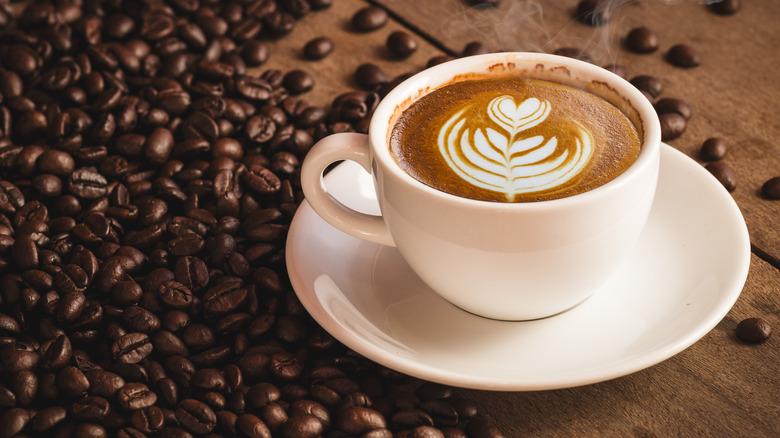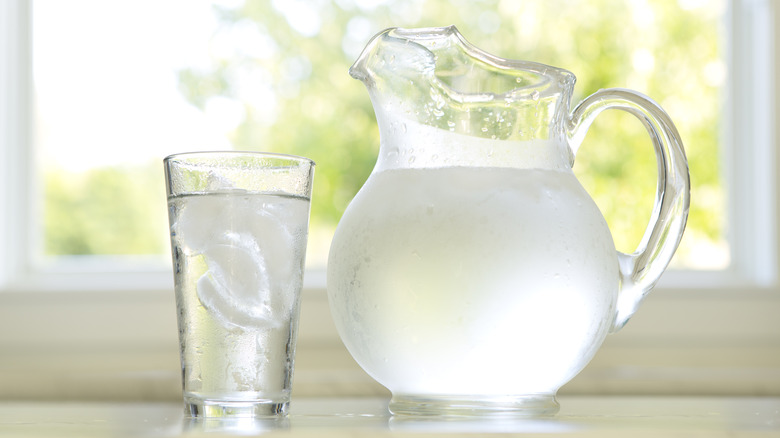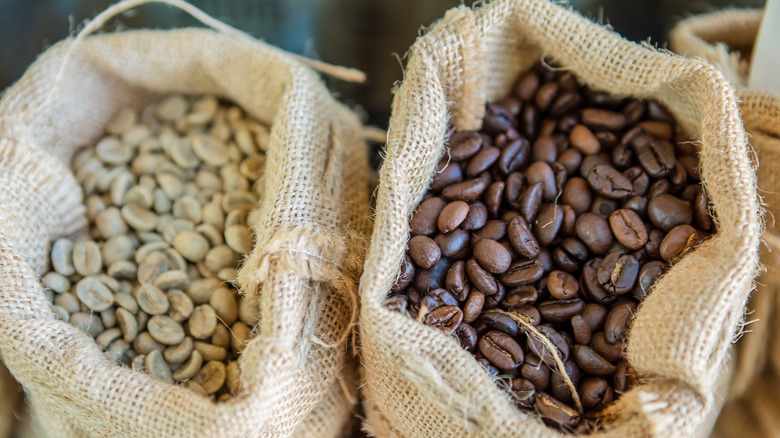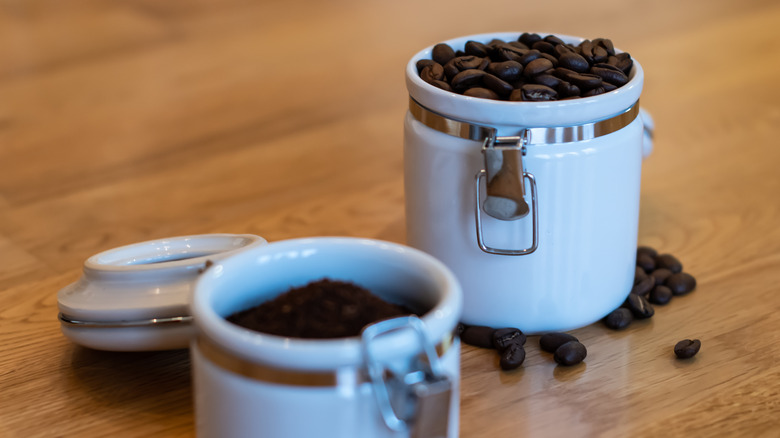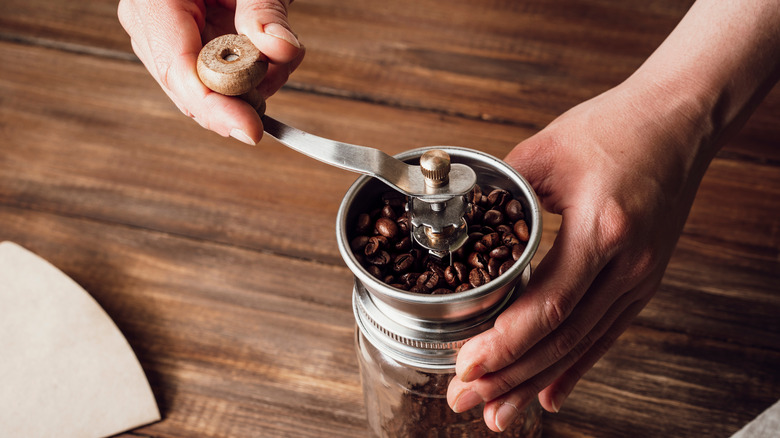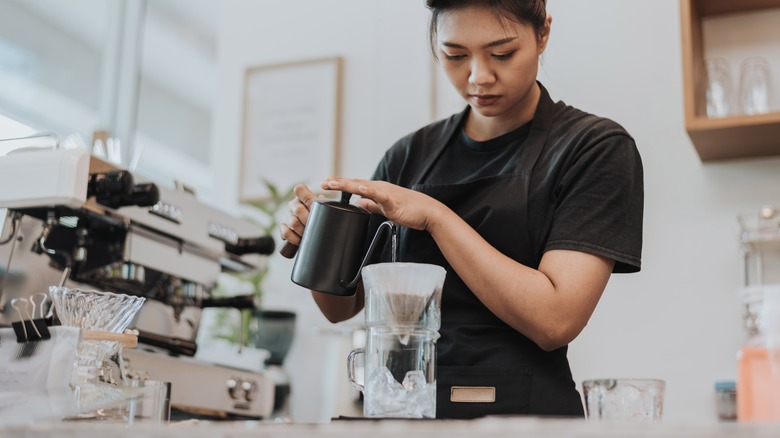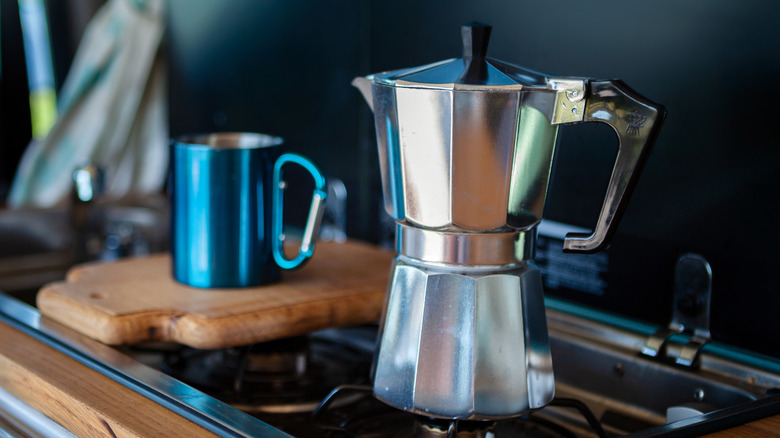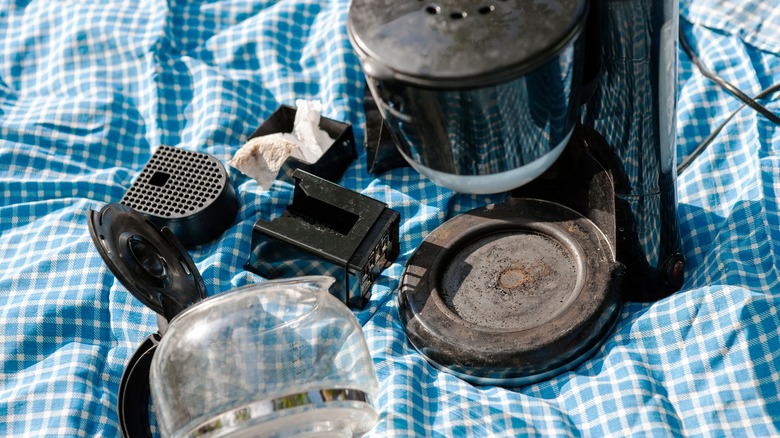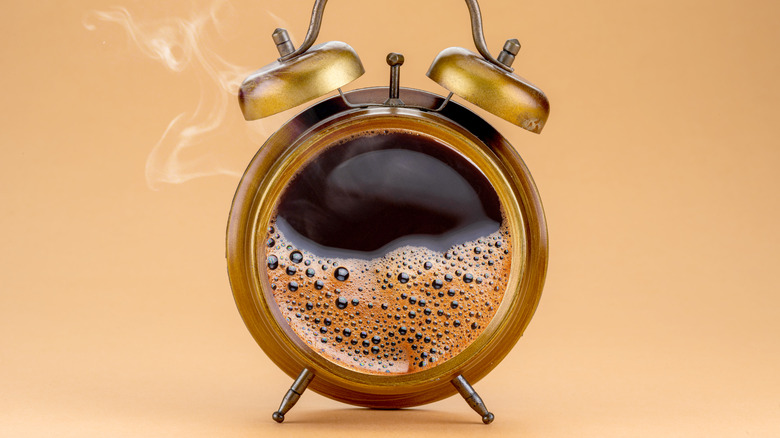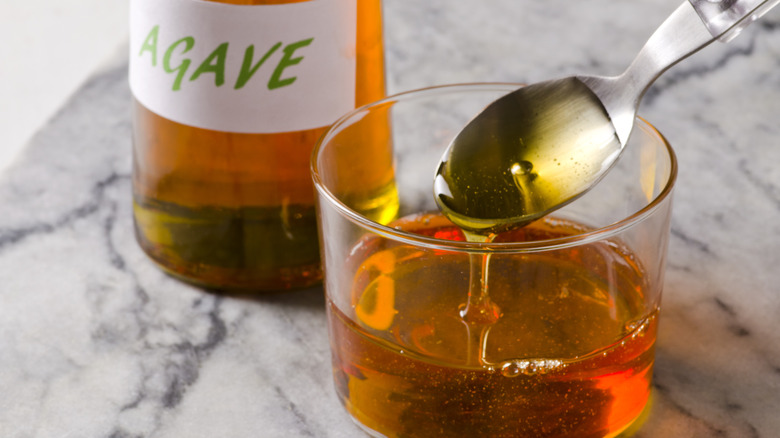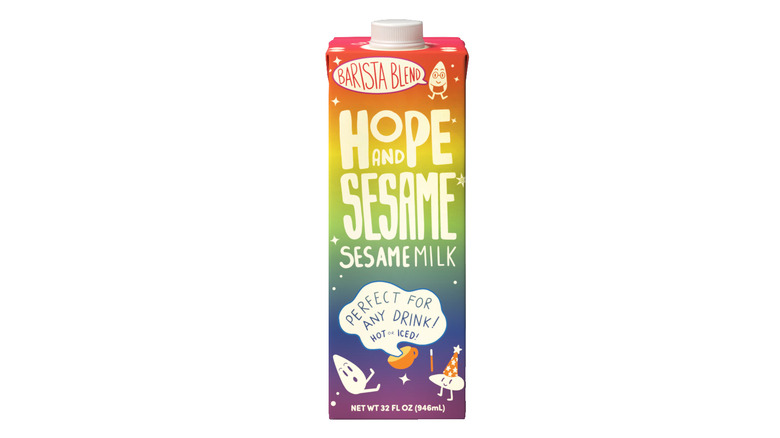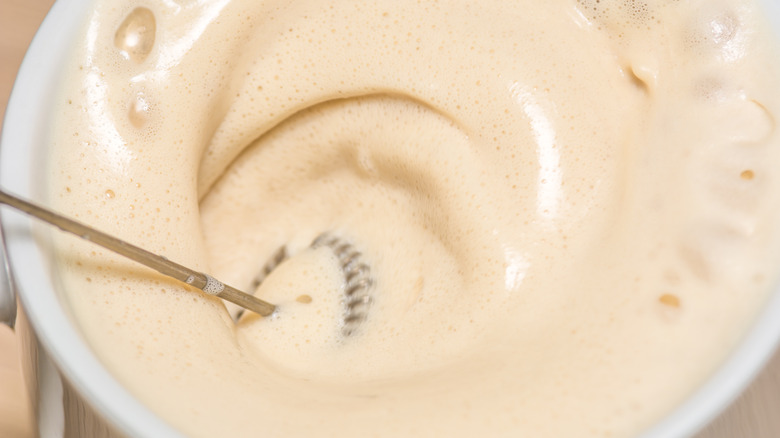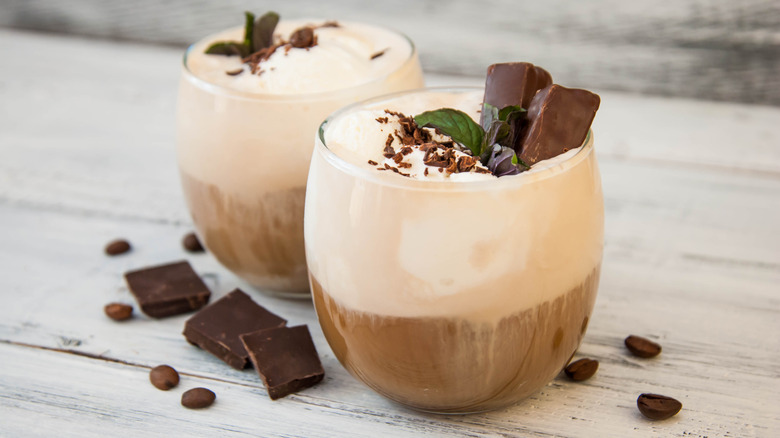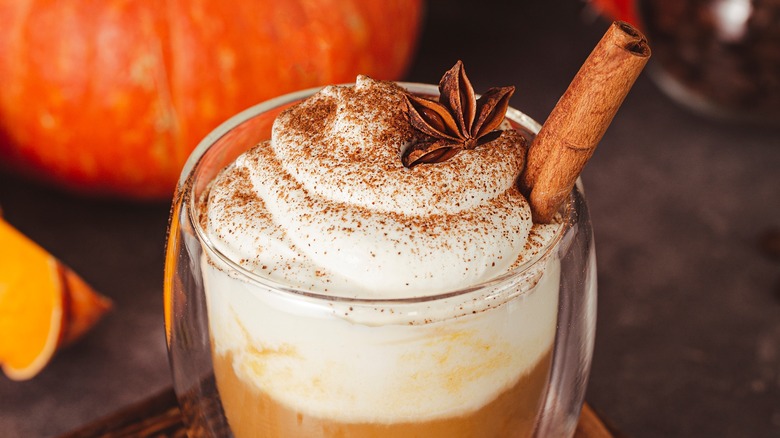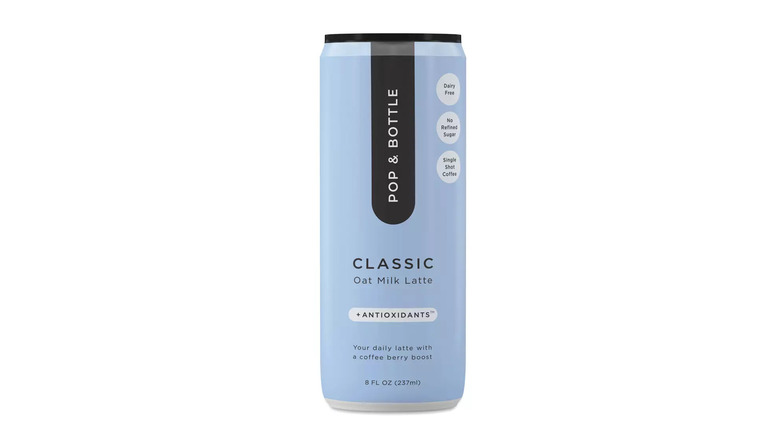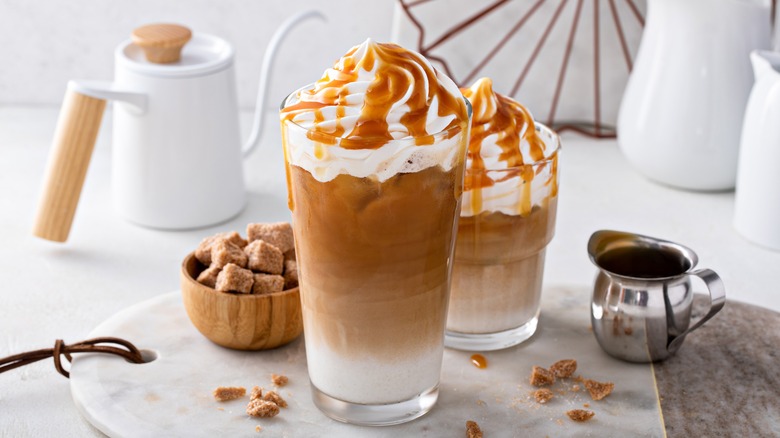Ways To Upgrade Your Morning Coffee
Humans absolutely love coffee. People around the world have been drinking and chewing it for over 600 years (via Bustle). Bach even wrote a cantata about it. In the United States, coffee became a daily drink during the American Revolution when the colonists boycotted overtaxed teas (via Vitacup). Soon coffee houses became public forums to discuss politics, even housing the first public reading of the Declaration of Independence. Today, 64% of Americans consume at least a single cup of coffee every day, and on average, Americans spend $1,100 a year on drinks from coffee shops like Starbucks (via Mashed) — more money than they'd invested that same year. Yikes.
One of the best ways to reduce your expenses and still live la vita caffè is to learn to make coffee like a barista. These days, the options for high-quality coffee, even at home, are endless. Sure, making the perfect cuppa does require a bit of knowledge and a can-do attitude, but once you've mastered the art of better-tasting coffee, you'll never return to either lousy at-home brewing or rely on expensive cafè drinks. Here are the secrets you need to know.
Start with clean, cold water
No matter how you make it, coffee starts with just two ingredients: coffee beans and water. The purity and temperature of your water will, in large part, determine how your coffee tastes. In both cases, cold water wins the day: The colder the water, the more oxygen it contains (via Coffee Lover's Cup). Heat reduces the amount of oxygen in water, so starting with oxygen-rich cold water allows more oxygen molecules to survive, even after boiling. These remaining oxygen molecules give your morning cuppa that freshly brewed flavor.
Cold water also contains fewer contaminants than hot water from the tap (via Denver Water). Because hot water boilers and tanks are made of metal, the heating systems themselves can erode over time, releasing contaminants — including heavy metals like lead — into the water coming from the hot spigots in your home. And unfortunately, boiling hot water won't remove those contaminants. Putting hot water in certain coffee machines with plastic parts can also cause damage to the machine, not to mention give your coffee an unwanted plasticky taste, notes the Coffee Detective. Stick to cold water, and you'll set the proper base for the rest of your brew.
Find the right roast for you
From acidic, citrusy cinnamon roast to darker-than-dark Italian roast, there's a bean for everyone (via Tasting Table). Coffee beans come in four general roasts: light, medium, medium-dark, and dark. Less processed beans contain more terroir — the taste of the ground in which the coffee trees grow. Roast the beans for longer, and the flavor transforms: Sugars caramelize, and the coffee becomes less acidic and more palatable to more people around the world. Experiment with different roasts to find your sweet spot.
When selecting coffee beans, you may also want to consider buying fair trade. According to Treehugger, fair trade-certified coffee brands operate with greater transparency and use third-party accountability to ensure that the coffee is produced under the best agricultural practices, with safe working conditions and fair pay, and causing the least environmental impact. For a dark, chocolatey roast, try Pure Origins' Organic Fair Trade Indonesia coffee. Want a lighter coffee with a hint of lemongrass and wild rice? Try Our Gorongosa's Elephants Never Forget direct trade light roast. Smack dab in the middle, with notes of nuts and caramel apple, is Grounds for Change's Nicaragua Miraflor medium roast.
Never freeze your beans
Unlike with your coffee water, "Cold is not recommended for preserving the integrity of beans," coffee entrepreneur Jeremy Lyman told Men's Journal. Many people who buy coffee beans in advance keep them in their kitchen freezer. But every time that door opens and closes, the beans defrost and refreeze ever so slightly, increasing the amount of humidity they absorb, which eventually interferes with the taste of the bean itself. Therefore, frozen beans are a common cause of a stale-tasting cup of joe.
The National Coffee Association USA warns that your cup of coffee's biggest foes are light, moisture, air, and heat. Keep peak flavor in your beans by storing them at room temperature in the pantry (not the fridge or the freezer). First, remove them from the store packaging, then place the beans in a dry, dark, sealed container. Keep your beans away from appliances that heat up and windows with a lot of sun exposure. The freshness of the roast begins to dissipate immediately, so buying your beans in smaller batches — one- or two-week supplies at a time — ensures you get a barista-quality cup every morning.
Match your grind to your machine
Sure, pre-ground coffee is convenient — simply scoop and brew. But there are several costs to this time-saving trick. Pre-ground beans expose more surface area to the air, reducing the freshness of the coffee, and the grind itself may be the wrong size for your coffee maker. To get the most out of your morning java, pick the grind that can extract the most flavor to make the best-tasting coffee possible for your brewing method (via Grosche).
In general, the longer water stays in contact with the ground beans, the coarser the grind should be. Your French press or cold-brew device will require chunky, coarsely ground beans. Pour-over coffee makers do best with a medium-coarse grind. For folks with basic automatic drip coffee makers, medium-ground beans around the size of salt crystals will provide the best taste. Making espresso? You'll want a fine grind that feels like sugar between your fingers. Espresso, in particular, is sensitive to the grind, so you may need to experiment to find the perfect size grind for you.
Perfect your coffee golden ratio
That ideal cup of coffee comes from perfecting the "coffee golden ratio," according to Wizard of Coffee. For most roasts, that's between 15 and 18 parts water to 1 part coffee. Remember: These units are not comparable to the volume of liquid in your cup of coffee. Because the coffee grounds are measured in weight, so is the water. In other words, you'll add a gram of coffee to anywhere between 15 and 18 grams (not ounces) of water.
That's where a scale steps in to save the day ... or at least your morning coffee. Selina Ullrich, director of coffee at East One Coffee Roasters, told Yahoo! Life that a small kitchen scale can give you the precision you need to achieve your perfect cup of coffee. Ullrich says, "The amounts you will need to measure will be small, and the higher specificity of this unit of measure will help to assure you are getting the accuracy and consistency you desire."
Experiment with both sides of the golden ratio to see what works best with your roast, grind, and machine. Ullrich compares this exercise to baking, another culinary area where ratios of ingredients matter greatly for taste and texture. When you pay attention to these tiny details, adds Ullrich, "you can optimize each and every coffee you try out."
Switch up your coffee maker
If your daily coffee routine is just not cutting it anymore, it's time to explore alternative brewing options. There's so much more to taste than what comes out of widely available automated drip machines. And not all of the options take up a ton of counter space or require special skills to make a great-tasting cup. Take, for example, the JoGo Straw, a nifty little device to make French-pressed coffee on the go (via Mashed). Get all the richness of your roast without having to set aside the time to boil and brew every morning — convenient and delicious.
For people concerned about single-use waste in coffee pod machines and fabric pour-over filters, the Bialetti Moka offers a quick, zero-waste, café quality coffee thanks to its innovative brewing method. Unlike many other coffee makers that use gravity to pull the water through the grounds, this iconic Italian stovetop espresso maker uses pressure to push the boiling water up through the grounds and into the chamber at the top of the coffee maker. For creamy espresso each and every morning, all you need is the right machine.
Keep your coffee maker clean
That bitter, funky taste in your coffee? It could be a signal that you need to clean your coffee maker (via Better Homes and Gardens). Over time, a buildup of oils from the coffee and mineral sediment from the water can accumulate inside the appliance, interrupting the flow of the brew and disrupting the careful balance of a great-tasting cup of joe. Coffee makers are also notorious breeding grounds for germs. One study by NSF International found that 50% of all home coffee machine water reservoirs contained both mold and yeast. Not only can these organisms ruin the flavor of your java, but they can also make you ill.
It's easy to tame unwanted bitterness and streamline the brewing process by giving your coffee machine a thorough cleaning. You don't need any fancy cleaners or tools — just some elbow grease, dish soap, vinegar, and water. With regular cleaning, you can keep germs at bay and ensure your freshest cup. For daily drinkers, monthly cleaning will suffice — adjust accordingly if you only enjoy coffee on occasion.
Don't drink day-old coffee
Many things in life can be upcycled for the better, but when it comes to the taste of coffee, time is of the essence. That's because oxidation profoundly affects the flavor profile of coffee (via Full Coffee Roast). In fact, coffee begins to lose flavor about 30 minutes after brewing (via Bustle). Four hours later, the oils turn acidic, giving old coffee its signature stale, bitter taste. And if left on the counter for 24 hours, coffee has the propensity to accumulate mold — both a flavor and a health hazard.
Equally important, if you drink coffee with dairy, that cup has about a two-hour lifespan before even reheating it, which might not kill all the bacteria that have accumulated during that time. However, if you've kept your coffee black — and in the refrigerator where airborne microbes and other environmental contaminants have been kept away from your brew — your day-old coffee could have another life. Try using it in tiramisu or make yourself an Irish coffee, where the coffee itself isn't the star of the show.
Experiment with sweeteners
There's so much more out there than just white table sugar to sweeten your coffee. Instead, give your cup of joe a new dimension with other common grocery store sweeteners. Molasses provides a dark, earthy flavor profile, and maple syrup adds its own depth (via Foods Guy). Using non-vegan honey may take a bit of getting used to (and has a higher calorie count than sugar), but agave can actually help counteract the bitterness of the coffee. Play around to see which options — and amounts — work best for you.
When it comes to calorie-free options, many people favor stevia because it is plant-derived, not synthetic like aspartame (per WebMD), and because it packs in 100 to 300 times more sweetness per serving compared to sugar — just a little goes a long way. But stevia can have a lingering metallic taste, so other natural calorie-free sweeteners like Purecane, a vegan-friendly derivative of sugarcane, and monk fruit, made from the Chinese Swingle fruit (per Food Insight), may provide the sweetness you seek. Again, how much of each sweetener will require some experimentation — but delicious attempts nonetheless.
Play with non-dairy milks and creamers
We have vegans to thank for the explosion of plant-based milk options now available on supermarket shelves. From peanuts to barley (via Golden Wing), never before have there been so many plant milk flavors and textures, some of which are better suited for your coffee needs than others. If you don't plan on heating, steaming, or frothing your milk and prefer just a dash of creamer, nutpods dairy-free creamer provides an excellent mouthfeel, with the sweet taste you'd expect from a heavy dairy cream.
If you're looking for that latte experience, you'll need to pay a bit more attention to your non-dairy milk. Some are specially formulated to behave like their dairy counterparts. These barista blends have higher fat content, allowing them to stretch and foam better than other types of lower-fat plant milk. Elmhurst 1925 offers pistachio, oat, and almond editions; and Hope and Sesame's Barista Blend not only foams beautifully, but it's also made from upcycled sesame seeds. With all these tasty options close at hand, even omnivores can be tempted to reach for a non-dairy milk.
Learn to froth your milk
Vegan or not, one of the best ways to upgrade your coffee is to froth your milk. When you take the time to do this, the entire texture of your coffee will be transformed. That's because frothing creates microbubbles that increase the volume of the milk, turning it into thick foam — baristas at coffee shops rely on this texture to create their art. This holds true for both vegan and non-vegan milk: The froth is where it's at.
Handheld, battery-operated frothers are inexpensive, easy-to-use daily coffee tools, but you don't need one to get bubbling. If you have a French press coffee maker, you can pump it to froth your milk. Fill a jar and shake it, whisk it in a bowl, or pulse it in a blender — there's no wrong way to froth. Frothed milk can also reduce bitterness and taste even sweeter than non-aerated milk. Make this switch, and turn your daily cup from blah to bam in just a few seconds.
Make it mocha
To upgrade your mocha skills, you've got to leave behind the chocolate syrup and dig deep into mocha's roots for tasty inspiration. The word "mocha" comes from Al Moka, a 17th-century port city in Yemen known for its chocolatey beans, but the drink you order at a coffee shop today comes from an Italian drink called the bicerin (via Coffee or Die). Baristas combined steamed milk, thick Italian-style hot chocolate (not watery American Swiss Miss-style cocoa), and espresso to make what we now know as a mocha.
To make mocha like a pro, always use milk instead of water; it provides the proper texture (via Cafe Toscana Restaurant). Also, don't go overboard on the chocolate. Your goal is to taste the chocolate without being overpowered by its sweetness. Bring out the flavor by adding a hint of vanilla flavoring. Congratulazione! You've got a mocha. For even more mocha goodness, use Nutiva's hazelnut spreads in lieu of hot chocolate. You can even turn your coffee into your breakfast by adding a pack of RDCL Superfoods' super cocoa protein powder, packing your coffee with everything you need to start the day — plus chocolate. Top it off with some powdered cocoa, and you'll be tipping yourself for a job well done.
Hit up the spice rack
If the hardcore fans of pumpkin spice lattes are any indication, coffee and spices make a wonderful team. Together, they can warm up your coffee in a way that a microwave can't. We're all familiar with cinnamon, nutmeg, and cloves, but what about less obvious choices like star anise, cardamom, or even lavender and cayenne?
Bon Appetit suggests adding your spices when you grind your beans, or even when you brew, to get the most flavor without grit winding up in the bottom of your mug. You don't need all that much spice, either. Use around ½ teaspoon of ground spices for every six cups of coffee. If you want a bit of texture on top, try Dona's Zero-Waste Spice Dust for a delightful dusting.
Perhaps the most underutilized spice in coffee-making is salt. If the beans you bought seem just a little too bitter, adding just a pinch of salt while brewing can reduce the acidity and round out your cup of joe. This pinch works great for both black and spiced brews.
Try an instant latte
Let's all just admit it: Not everyone is a morning person. All the hullabaloo about making your morning coffee better sounds great, but in practice, for many it's probably never gonna happen. Fortunately for those folks, the perfect coffee is just a cup of hot water away from an instant latte (via LA Weekly). Leave grocery store brand latte mixes behind and up your coffee game with Clevr Blends' Coffee SuperLatte. This oat milk and superfood latte fluffs up beautifully with a milk frother and tastes so creamy, even dairy lovers will want to add this to their pantries. The best brews latte sampler from Copper Cow Coffee offers single-serve Vietnamese-style pour coffee with five tantalizing flavors, including lavender and churro. The sustainably-sourced sampler comes with individual sweetened condensed milk creamers, to complete your perfect morning coffee in less than 90 seconds.
Cold brew aficionados will love Pop & Bottle's oat milk lattes. Each of the four coffee flavors has the perfect balance of bean, milk, and sweetener (vegans, take note: the vanilla contains fish collagen). Use your favorite milk or creamer with Pop & Bottle's triad of concentrates — coffee fast, easy, and with flavors to suit everyone. Intelligensia's new vegan lattes come in two flavors, but for the price, you may as well be buying coffee out.
Get fancy with the toppings
Channel your inner child at the self-serve fro-yo station and go wild with the coffee toppings (via Coffee Affection). But don't just reach for your basic vanilla and toffee syrups. Expand your palate with more adventurous options such as Transcendence Coffee's Algerian baklava syrup. Rich in notes of orange blossom buds and honey, the syrup pairs perfectly with a lighter roast for a bright, perfectly sweet, citrusy cup of coffee. Even more exotic is their Indian gulab jamun syrup, bringing the flavors of the East, including cardamom, saffron, and rose petals, to your morning cuppa. And take a caramel coffee to the next level with Just Date's chai caramel. Made by simmering dates in coconut milk, the warming spices in this syrup will sizzle up your cup — all without refined sugars.
Want more than just flavor? Try adding some texture. Sure, chocolate chips, cacao nibs, and marshmallows pair perfectly with mocha, but there's no rule that says you can't add them to every cup of coffee. And no topping list would be complete without whipped cream. Purchase your vegan or non-vegan whipped cream in a can (via Cooking Light), or put some elbow grease into whipping your own. Now take a look at your beautiful morning coffee. The day feels better already, doesn't it?
